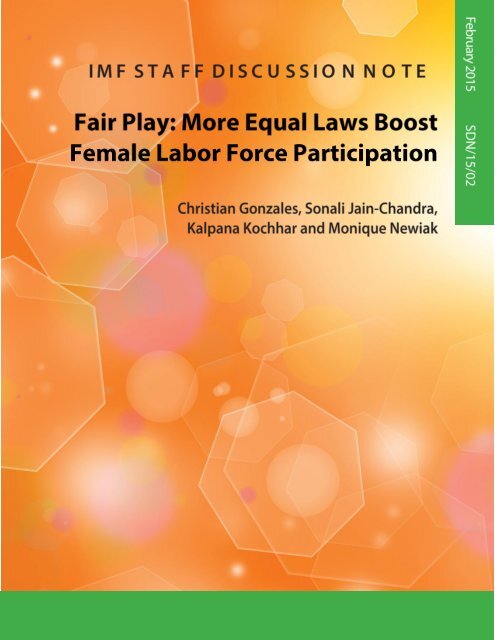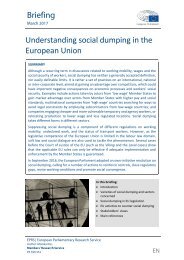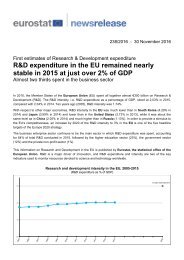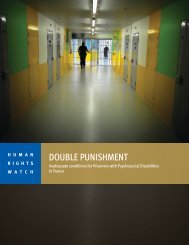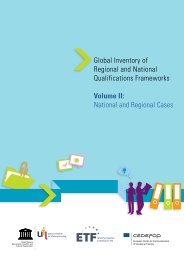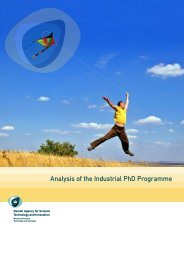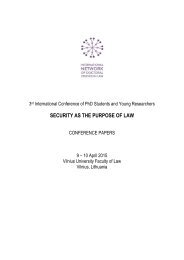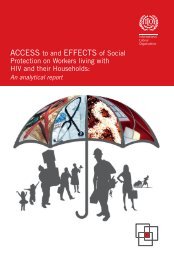ltmr5kq
ltmr5kq
ltmr5kq
You also want an ePaper? Increase the reach of your titles
YUMPU automatically turns print PDFs into web optimized ePapers that Google loves.
FAIR PLAYFair Play: More Equal Laws Boost Female Labor Force ParticipationPrepared by Christian Gonzales, Sonali Jain-Chandra, Kalpana Kochhar, and Monique NewiakAuthorized for distribution by Kalpana KochharDISCLAIMER: This Staff Discussion Note represents the views of the authors and does notnecessarily represent IMF views or IMF policy. The views expressed herein should be attributed tothe authors and not to the IMF, its Executive Board, or its management. Staff Discussion Notesare published to elicit comments and to further debate.JEL Classification Numbers: J21, J16, K1, K3, O1,Keywords:Authors’ E-mail Addresses:female labor force participation, gender equity, legalrightsCGonzales@imf.org, SJainChandra@imf.org,KKochhar@imf.org, MNewiak@imf.orgINTERNATIONAL MONETARY FUND 2
FAIR PLAYCONTENTSEXECUTIVE SUMMARY __________________________________________________________________________ 4INTRODUCTION _________________________________________________________________________________ 5RELATED LITERATURE ___________________________________________________________________________ 7A. Demographics _________________________________________________________________________________ 7B. Fiscal Policy ____________________________________________________________________________________ 8C. Institutions ____________________________________________________________________________________ 10D. Signaling Effects ______________________________________________________________________________ 11LEGAL RESTRICTIONS AND FEMALE LABOR FORCE PARTICIPATION _______________________ 12A. Empirical Strategy_____________________________________________________________________________ 12B. Restrictions on Women’s Rights: Data Description ____________________________________________ 13C. Legal Restrictions and Female Labor Force Participation: Stylized Facts _______________________ 16D. Empirical Results ______________________________________________________________________________ 21CONCLUSIONS AND POLICY RECOMMENDATIONS __________________________________________ 27ANNEXES_________________________________________________________________________________________27Annex 1. Data Sources and Descriptions of Variables_____________________________________________28Annex 2. Econometric Methodology______________________________________________________________31REFERENCES ____________________________________________________________________________________ 33BOXES1. Theoretical Underpinnings of Female Labor Supply: A Selective Literature Survey ____________ 122. Fifty Years of Legal Rights _____________________________________________________________________ 153. Constitutional Reforms in Kenya ______________________________________________________________ 21FIGURES1. GDP Losses due to Economic Gender Gaps in Selected Countries ______________________________ 52. Demographic and Policy Drivers of Female Labor Force Participation __________________________ 93. Restricted Resources and GDP ________________________________________________________________ 114. Evolution of Legal Gender-Based Restrictions, 1960 and 2010 ________________________________ 165. Gender-Based Restrictions Across Countries __________________________________________________ 186. Gender Gaps in Economic Participation and Legal Restrictions, 2010 _________________________ 197. Changes in Female Labor Force Participation Rates after Selected Legal Changes ____________ 208. Explaining Gender Gaps in Labor Force Participation: Results for OECD Sample ______________ 249. Explaining Gender Gaps in Labor Force Participation: Results for Emerging Market andDeveloping Country Sample___________________________________________________________________________26TABLES1. Labor Force Participation Gaps and Legal Restrictions—OECD Country Sample_______________232. Labor Force Participation Gaps and Legal Restrictions—Emerging Market and DevelopingCountry Sample ___________________________________________________________________________________25INTERNATIONAL MONETARY FUND 3
FAIR PLAYEXECUTIVE SUMMARYThis Staff Discussion Note examines the effect of gender-based legal restrictions and other policychoices and demographic characteristics on female labor force participation. Drawing on a largeand novel panel data set of gender-related legal restrictions, the study finds that restrictions onwomen’s rights to inheritance and property, as well as legal impediments to undertakingeconomic activities such as opening a bank account or freely pursuing a profession, are stronglyassociated with larger gender gaps in labor force participation. These factors have a significantadditional impact on female labor force participation over and above the effects of demographiccharacteristics and policies. In many cases, the gender gaps caused by these restrictions alsohave macro-critical effects in terms of an impact on GDP.The results from this study suggest that it would be beneficial to level the playing field byremoving obstacles that prevent women from becoming economically active if they choose to doso. In recommending equal opportunities, however, this study does not intend to render ajudgment of countries’ broadly accepted cultural and religious norms.INTERNATIONAL MONETARY FUND 4
FAIR PLAYINTRODUCTION1. The participation of women in the labor force is in itself an important social anddevelopment goal, but it is also crucial from an economic growth and stability perspective.The World Bank’s 2012 World Development Report argues that gender equality matters in its ownright, but that it is also “smart economics” because it can enhance economic efficiency. TheWorld Economic Forum’s 2014 Global Gender Gap Report finds a positive correlation betweengender equality and per capita GDP, the level of competitiveness, and human developmentindicators.2. A growing body of literature points to the relationship between femaleparticipation in the labor force and economic growth (IMF 2013). Various studies highlightthat gender gaps in labor force participation, entrepreneurial activity, and education impedeeconomic growth (Cuberes and Teignier 2014; Esteve-Volart 2004; Klasen and Lamanna 2009).Cuberes and Teigner (2012) simulate an occupational choice model that imposes several frictionson economic participation and wages of women, and show that gender gaps in entrepreneurshipand labor force participation significantly reduce per capita income. Figure 1 shows countries forwhich the gain in GDP from closing gender gaps is at least 15 percent. In rapidly agingeconomies, higher female labor force participation can directly yield growth and stability gainsby mitigating the impact of a decline in the labor force on growth potential (Steinberg andNakane 2012). The opportunity for women to earn and control income has been associated withbroader economic development (Heintz 2006), and total factor productivity gains (Loko andDiouf 2009).Figure 1. GDP Losses due to Economic Gender Gaps in Selected Countries(Percent of GDP) 1Source: Estimates by Cuberes and Teignier (2014).1 Losses are estimated for a particular year for each country and can thus be interpreted as a one-off increasein GDP if gender gaps were to be removed.INTERNATIONAL MONETARY FUND 5
FAIR PLAY3. Previous empirical work has identified demographic characteristics andgovernment policies as the key drivers of female labor force participation. In terms ofdemographic drivers, studies have highlighted the role of fertility and educational attainment.Government expenditure policies, including maternity leave and child benefits as well as taxpolicies, have also been shown to significantly affect women’s economic participation. The effectof legal gender-based restrictions on women’s labor force participation, however, has been lessexplored in a systematic way.4. A novel and rich dataset on legal restrictions allows us to examine their effect onwomen’s labor force participation for a large set of countries over a long time horizon. TheWorld Bank’s Women, Business and the Law Database (WBL) presents a number of indicators onlegal restrictions and regulations relating to women’s economic participation andentrepreneurship, including limitations related to accessing institutions, owning and managingproperty, getting a job (such as restrictions on women’s work, including working at night or incertain industries), building credit, and going to court. The database provides detailedinformation on the manner in which laws and regulations have been used to establish differenceson the basis of gender, generally to the disadvantage of women. For selected indicators, thedatabase allows for tracking legal changes back to 1960, providing ample information to assessthe economic effects of such restrictions.5. The main contribution of this study is to analyze the effect of different legalrestrictions on gender gaps in labor force participation for a large panel of countries. Inaddition to including legal restrictions in the analysis, this note expands empirical coverage usedin recent papers by (1) updating major parts of the comparative family policy database ofGauthier (2011) to include more recent years, and (2) substantially expanding the number ofcountries compared with previous empirical studies (Steinberg and Nakane 2012).6. The main finding of this study is that less legal discrimination against women isstrongly associated with higher female labor force participation. The empirical resultshighlight that legal equality in economic rights significantly contributes to explaining thevariation of labor force participation gaps across countries and time. In particular, the followingfactors are all related to a statistically significant decrease in the gender gap in labor forceparticipation: legally guaranteed equality between men and women; equal property rights; equalinheritance rights for sons and daughters; joint titling for married couples; women’s liberty topursue a profession, obtain a job, or open a bank account; a woman’s right to initiate legalproceedings without her husband’s permission; right to sign a contract; and a woman’s right tobe the head of a household. These effects come in addition to other factors, such asdemographics, education, and family policies that have the expected sign and are statisticallysignificant in the regression analysis.7. The policy implication of these findings is clear: countries that want to increasefemale labor force participation would do well to review and reform legal rules andinstitutions with a view to creating a level playing field. That said, this study does not take aposition on a woman’s family-work choices. Many studies rightly note the significance of theINTERNATIONAL MONETARY FUND 6
FAIR PLAYwork is also reflected in a negative correlation between female labor force participation andmarriage rates.11. Educational attainment for women is positively correlated with female economicparticipation. Calibrating a dynamic model of labor supply, Eckstein and Lifshitz (2011) find thatone-third of the increase in female employment during the last century in the United States canbe attributed to education. In an empirical exercise, Steinberg and Nakane (2012), show that aone standard deviation increase in the education level in OECD countries is associated with a 3percentage point increase in female labor force participation.B. Fiscal Policy12. The scope for increasing female labor force participation through tailored andcountry-specific fiscal policies is significant (Aguirre and others 2012; Duflo 2012; Revengaand Shetty 2012; Sen 2001; Thévenon 2013; Kalb 2009). On the revenue side, tax credits orbenefits for low-wage earners can stimulate labor force participation, including among women.By reducing the net tax liability or even turning it negative, tax credits increase the net incomegain from accepting a job. Such credits are usually phased out as income rises. Policies can alsobuild on the fact that female labor supply is more responsive to taxes than male labor supply(IMF 2012). For example, a switch from family income taxation to individual income taxation thatreduces the tax burden for (predominantly female) secondary earners can increase female laborforce participation, while it would affect the less-tax-elastic male labor supply to a smaller extent.13. As for expenditure policy, better access to comprehensive, affordable, and highqualitychild care frees up women’s time for formal employment (Gong, Breunig, and King2010). The elasticity of female labor supply with respect to the price of child care has been shownto range from –0.13 to –0.2. Thus, reducing the price of childcare by 50 percent could beassociated with an increase of 6.5 to 10 percent in the labor supply of young mothers. Otherstudies (Ghani, Kerr, and O’Connell 2013; Norando 2010) document the importance of publicinfrastructure to boost the participation of women in the labor force. Norando (2010) finds that alarge part of the difference in female labor force participation rates in 1990 between the UnitedStates, on the one hand, and Brazil and Mexico, on the other, can be explained by the availabilityof basic infrastructure (electricity and running water). Ghani, Kerr, and O’Connell (2013) note thatinadequate infrastructure affects women’s participation more than that of men because womenare more often responsible for household activities.INTERNATIONAL MONETARY FUND 8
FAIR PLAYFigure 2. Demographic and Policy Drivers of Female Labor Force ParticipationSources: Barro and Lee (2014); OECD, Family Database, Social Expenditure Database (SOCX), Gender Portal, andLabor Force Statistics.14. The availability of maternity leave can encourage greater participation, but itseffects can be nonlinear. In other words, while properly designed family benefits can helpsupport female labor force participation (Jaumotte 2003), long periods outside the labor marketalso risk reducing skills and earnings (Ruhm 1998; Edin and Gustavsson 2008). Independently ofits duration, paid parental leave appears to have a negative effect on the gender gap in earningsINTERNATIONAL MONETARY FUND 9
FAIR PLAYof full-time employees (Thevenon and Solaz 2013). As parental leave is mostly taken by women,it can indirectly encourage employer discrimination and discourage employers from hiringwomen for positions that require costly qualification and training periods (Mandel andSemyonov 2005). This implies that policies that encourage greater parity between paternity andmaternity leave could support a more rapid return to work among mothers and help shiftunderlying gender norms (World Bank 2012).C. Institutions15. Gender-based legal restrictions impede women’s empowerment and thus theireconomic participation. In addition, weak or restrictive laws related to family, gender-basedviolence, and economic opportunities are most likely to impede women’s empowerment, with alack of gender parity in business and institutional laws strongly associated with lower levels ofeconomic participation by women (Klugman and Twigg 2012; World Bank and IFC 2013).16. Social institutions associated with more gender equality have been shown to bestrongly positively related with better development outcomes and living standards (Figure3). More equal property rights for men and women stimulate investment by eliminatinginefficiencies, are associated with higher GDP per capita, and can shift the composition of publicspending related to health, education, and children (Doepke, Tertilt, and Voena 2012). Usinginformation from the OECD’s Social Institutions and Gender Index (SIGI), 1 Branisa and Klasen(2013) show that the existence of institutions that perpetuate gender inequality is associated withlower female secondary education, higher fertility rates, higher child mortality, and a greaterperception of corruption in the respective country. They propose, among other things, thepassage of anti-discrimination laws or the introduction of programs in support of women andgirls.1 As a composite index, the SIGI scores countries on 14 indicators, grouped into five subindexes—discriminatoryfamily code, restricted physical integrity, bias toward sons, restricted resources and assets, and restricted civilliberties—that measure different dimensions of social institutions related to gender inequality. The SIGI is anunweighted average of the five subindexes. The SIGI is available at http://www.genderindex.org/.INTERNATIONAL MONETARY FUND 10
FAIR PLAYFigure 3. Restricted Resources and GDPSource: OECD, Social Institutions and Gender Index (2014).http://www.genderindex.org/.Note: PPP = purchasing power parity.D. Signaling Effects17. Women in leadership positions may also increase female labor force participationby providing role models for other women, and by combating stereotypes. The introductionof quotas for women in political positions has been shown to increase women’s politicalparticipation and votes for women. In Rwanda, the constitutionally guaranteed quota of 30percent of women in Parliament has been filled and indeed exceeded (Klugman and Twigg 2012).By weakening stereotypes about gender roles, the use of quotas for women in leadershippositions in Indian village councils has led to a greater likelihood of women standing for electedpositions in these councils. Also, once women are in charge, they can significantly change publicattitudes toward women and, importantly, raise the aspirations parents have for their daughtersand the aspirations teenage girls have for themselves (Beaman and others 2009). Theintroduction of female quotas in Italy in the 1990s tripled the probability of voting for women(De Paola, Scoppa, and Lombardo 2010) and increased female representation in politics (Bonomi,Brosio, and Di Tommaso 2013). Kang (2013) found that the success of gender quota laws inNiger depended on the design of the law, the institutional context, and having female activistsmonitoring its application.INTERNATIONAL MONETARY FUND 11
FAIR PLAYBox 1. Theoretical Underpinnings of Female Labor Supply: A Selective Literature SurveyFemale labor supply is often modeled using the framework of the time allocation model (Becker1965), which posits that women make their labor supply decisions not only considering leisureand labor, but also home-based production of goods and services (including caring forchildren). As Jaumotte (2003) points out, working for a wage is chosen only if earnings at leastmake up for the lost home production (and the associated costs), implying a higher elasticity offemale labor supply to wages.Most studies have emphasized the importance of education in models of female laborsupply. A number of studies have also included wages as a key in modeling female laborsupply models (Heckman and MaCurdy 1980). Fernandez and Wong (2014) develop adynamic life-cycle model with incomplete markets and risk-averse agents who differ in theireducational endowments and make work, consumption, and savings decisions. They findthat, in addition to the above factors, divorce risk has a large impact on married women’sparticipation rates.Eckstein and Lifshitz (2011) estimate a dynamic stochastic female labor supply model withdiscrete choice (contained in Eckstein and Wolpin 1989) and find that changes in education(accounting for a third of the increase in female employment) and wages (explaining about20 percent) play a large role in explaining female employment. They also formulate a newframework that models intra-family dynamics (using dynamic stochastic games) and relate itto the household’s labor supply decision.LEGAL RESTRICTIONS AND FEMALE LABOR FORCEPARTICIPATIONA. Empirical Strategy18. This study empirically assesses the relationship between the presence of legalrestrictions and female labor force participation. The estimations include legal restrictions inaddition to other standard determinants of female labor force participation. As noted earlier,previous empirical work has identified demographic characteristics such as fertility, educationalattainment, and policies (including maternity leave and child benefits) as the key drivers offemale labor force participation.INTERNATIONAL MONETARY FUND 12
FAIR PLAY19. For a set of OECD countries and a sample of emerging market and developingcountries, panel regressions are estimated as follows: 2whererefers to the male labor force participation rate minus the corresponding rate forfemales in country i at time t. includes the fertility rate, and refersto the years of schooling from the Barro-Lee database.maternity leave provided (data available for OECD countries only).refers to the number of weeks ofincludes the variouslegal restrictions contained in the WBL Database, as described below. Country fixed effects areincluded to capture other country specific factors. 3B. Restrictions on Women’s Rights: Data Description20. The World Bank’s Women, Business and the Law Database focuses on how laws andregulations differentiate between men and women, and in turn alter incentives to join thelabor force. 4 When men and women are subject to different laws, women typically faceinstitutions that are stacked against them. This study asks whether these differences can explainthe gap between male and female labor force participation. The purpose here is to see if suchlegal differences in treatment have an impact on female labor force participation rates over andabove the widely discussed determinants of women’s participation, including unfavorable taxregimes, gender wage gaps, and educational gaps. The WBL database is based on existing laws(de-jure) and does not take into account how laws are put into practice (de-facto). As a result, inthe absence of comprehensive data on the practical application of laws across countries, thisstudy relates existing legal restrictions to gender gaps in participation.21. The WBL database provides detailed information on legal restrictions on women’seconomic participation. It contains data on legal and regulatory barriers to women’s economicparticipation and entrepreneurial activity in 143 countries, and focuses on seven indicators ofgender-related differences in the legal and institutional framework:1) Accessing institutions: Represents women’s legal ability to interact with public authorities(for example, the acquisition of national identity cards);2) Using property: Explores a woman’s legal rights to own, control, and inherit property;2 See Annex 1 of a description of the dataset and definitions of variables and Annex 2 for details on theeconometric methodology.3 We test for whether time dummy variables need to be included to control for the time trends. In the F test, wefail to reject the null that the coefficients for all years are jointly equal to zero, therefore no time fixed effects arerequired.4 The WBL database is available at http://wbl.worldbank.org/data.INTERNATIONAL MONETARY FUND 13
FAIR PLAY3) Getting a job: Analyzes restrictions on women’s work (for example, restrictions on nightshifts for women);4) Providing incentives to work: Assesses tax considerations (such as tax credits anddeductions available to women relative to men);5) Building credit: Assesses access to finance;6) Going to court: Examines access to small claims court and the weight provided to awoman’s testimony; and7) Protecting women from violence: Assesses the strength of laws to prevent violenceagainst women.For two WBL indicators—accessing institutions and using property—the dataset providesdetailed information for 100 economies spanning the period from 1960 to 2010 (Box 2).22. Gender-based legal restrictions are significant in a number of countries. Despiteprogress over time, the WBL data suggest that almost 90 percent of the economies have at leastone such restriction. Some countries have numerous legal restrictions, with some 28 countrieshaving in place 10 or more restrictions on women’s participation.23. The nature of the restrictions varies across countries. In some countries, husbandscan prevent their wives from working altogether, while in others (79 countries), there are lawsthat restrict women’s participation in specific professions. Other restrictions impede women’sproperty rights and thereby their access to finance. Specifically, the WBL report shows that incountries with property rights more favorable to women, there is greater financial inclusion ofwomen (10 percentage points more bank accounts owned by women). Gender-based differencesin property rights also make it more difficult for women to deploy immovable property ascollateral in order access credit.INTERNATIONAL MONETARY FUND 14
FAIR PLAYBox 2. Fifty Years of Legal RightsThe 50 Years of Legal Rights Database tracks changes in women’s right to access legal institutions and useproperty for 100 economies over a period of 50 years. 1Accessing legal institutions. Information compiled in this category of the database examines the degreeto which the legal ability of women to interact with public authorities and the private sector is differentfrom that of men. The information addresses questions in the following areas:Women’s status and capacity Access to the Judicial System Constitutional RightsCan adult married womenbecome a head of householdor head of a family?Can married women get ajob/pursue profession?Can married woman open abank account?Can married woman sign acontract?Can married women initiatelegal proceedings withouttheir husband's permission?Guaranteed equalityNondiscrimination clausecovering gender/sexIs customary law valid under theConstitution?Customary law invalid if itviolates nondiscriminationclauseIs religious law valid under theConstitution?Religious law invalid if it violatesnondiscrimination clauseUsing property. Questions addressed in this category relate to women’s ability to own, manage, control,and inherit property:Property Ownership Marital Regimes InheritanceDo unmarried women have What is the default marital equal property rightsproperty regime? 2concerning immovable property?Do married women have equalproperty rights concerningimmovable property?Is joint titling of property thedefault case for marriedcouples?Do sons and daughters haveequal inheritance regardingimmovable property?Do surviving spouses haveequal inheritance regardingimmovable property?1The database is available at http://wbl.worldbank.org/methodology/historical-data-methodology2Each of the examined property regimes confers a different degree of financial independence on women. In the fullcommunity property regime, all assets and income brought into a marriage as well as acquired during the marriage aretreated as jointly owned. At the other end of the spectrum, there is the separation of marital property, in whichproperty acquired during or before marriage is not jointly owned. Community property regimes recognize thenonmonetary contributions of women. They allow women to acquire wealth and provide for greater financial security,and they determine how women can buy, sell, or use property as collateral.24. There has been a steady easing of legal restrictions against women and thereby agradual leveling of the playing field in most countries (Figure 4). Between 1960 and 2010,280 changes took place in the gender-based legal framework, mostly in the areas of introducinga nondiscrimination clause based on gender, female property rights, and the legal ability ofmarried woman to get a job and pursue a profession. The data show that more than half of therestrictions in accessing institutions and using property in place in 1960 had been removed byINTERNATIONAL MONETARY FUND 15
FAIR PLAY2010. The restriction on married women working (for example, needing their husband’spermission) was removed in 23 countries, most recently by Turkey in 2001, and in South Africaand Guatemala in 1998. Restrictions on married women opening a bank account were relaxed in20 countries in the sample, most recently by Mozambique in 2004 and Lesotho in 2006.Figure 4. Evolution of Legal Gender-Based Restrictions, 1960 and 2010(In percent of total observations)Source: World Bank, Women, Business and the Law Database and IMF staff estimates.25. Despite this progress, gender-related restrictions are still in place (Figure 5). Thenumber of gender-based restrictions remains high in particular in the Middle East and NorthAfrica, sub-Saharan Africa, and South Asia. This continued prevalence of gender bias injurisdictions is confirmed by rankings from related databases as well. For example, the OECD’sSocial Institutions and Gender Index (SIGI index) which is highly correlated with a number ofsubcomponents of the WBL, including equal inheritance rights and the rights of women to get ajob or pursue a profession. Similarly, country rankings in the World Economic Forum’s GlobalGender Gap Index are highly correlated with those in the WBL and SIGI databases (WEF 2014).C. Legal Restrictions and Female Labor Force Participation: StylizedFacts26. The data suggest that there is a strong relationship between legal restrictions andlabor market participation rates for women across countries. Figure 6 shows that, for asample of almost 100 countries, more equitable property rights and more equal rights to obtaina job or pursue a profession are associated with lower gender gaps in labor force participation,without significantly affecting male participation rates. Similar results hold for the relationshipwith labor force participation gaps with other economic rights. The right-side panels in Figure 6indicate that smaller participation gaps in countries with no gender-based legal restrictions aredriven by higher female labor force participation compared with countries with legal restrictions.There is considerable variation in female participation across countries, but averages are higherINTERNATIONAL MONETARY FUND 16
FAIR PLAYand the range is narrower in countries where there are no legal differences for men and women.For instance, in countries with unequal inheritance rights for girls and boys (upper right-sidepanel in Figure 6) female participation rates vary from 23 percent to almost 60 percent, asopposed to countries with equal property rights, where female participation is in the narrowerrange of 40 to 60 percent (the midpoint is higher in the latter case). This suggests that otherimportant cross-country characteristics, such as demographics, preferences, and other policies,are additional explanatory factors that also play an important role.INTERNATIONAL MONETARY FUND 17
FAIR PLAYFigure 5. Gender-Based Restrictions Across Countries(OECD 2014 Social Institutions and Gender Index)Source: OECD, Social Institutions and Gender Index (2014). http://www.genderindex.org/.Note: Numbers in the map indicate SIGI ranking (1 = very low degree of discrimination, 5 = very high degree of discrimination). Numbers insidecountries denote countries’ rank among all assessed countries (1 = best).INTERNATIONAL MONETARY FUND 18
FAIR PLAYFigure 6. Gender Gaps in Economic Participation and Legal Restrictions, 2010Gender gaps in labor force participation are only half … and deviations around the mean labor forcethe size in countries without gender-based differences participation rates in these countries are smaller.in inheritance rights….Women are also more likely to join the labor market inwhich their pursuit of a profession is not restricted…… and female labor force participation does not appear tosubstitute for male participation in these countries.Sources: World Bank/International Finance Corporation (2013); World Bank, World Development Indicators andIMF staff estimates.Note: FLFP = female labor force participation; MLFP = male labor force participation.27. Legal changes have also on average been associated with marked increases in femalelabor force participation over time. The top left panel of Figure 7 plots the median female laborforce participation rates for countries in which equality of men and women was constitutionallygranted. The year of the change is shown in the figure as T = 0. It shows that, in 50 percent of thecountries where equity was legally granted, female participation increased by some 5 percentagepoints in the following five years. Such large increases in female labor force participation are likelyto have a significant effect on economic growth. Similar results hold for other rights, such as theright to open a bank account (top right panel of Figure 7).INTERNATIONAL MONETARY FUND 19
FAIR PLAY28. In some countries, several favorable changes in laws made during the course of ayear have been found to have had strong effects on female labor force participation (Box 3).For example, in 1996 Namibia passed the “Married Persons Equality Act,” which triggered sixchanges in the WBL classification. In particular, the law equalized property rights for marriedwomen and granted women the right to sign a contract, head a household, pursue a profession,open a bank account, and initiate legal proceedings without the husband’s permission. In Peru,customary law was abolished as a valid source under the Constitution in 1993, and invalidated if itviolated the nondiscrimination clause. Malawi introduced similar laws invalidating customary law in1994, combined with a nondiscrimination clause and equal inheritance rights for surviving spouses.Namibia and Peru experienced substantial increases in female labor force participation rates of 10and 15 percentage points, respectively, in the decade that followed those changes (Figure 7,bottom panels). In Malawi, female labor force participation rates increased further from alreadyhigh levels.Figure 7. Changes in Female Labor Force Participation Rates after Selected Legal ChangesSources: World Bank, Women, Business and the Law Database; and IMF staff estimates.INTERNATIONAL MONETARY FUND 20
FAIR PLAYBox 3. Constitutional Reforms in KenyaThe 2014 World Women, Business and the Law (WBL) report by the World Bank and InternationalFinance Corporation points to constitutional reforms in Kenya in 2010 as leading to changesequalizing women’s legal status. Kenya’s Constitution has prohibited gender discrimination since 1997.However customary law—traditional rules governing personal status and communal resources—was exemptfrom this nondiscrimination clause and prevailed in a number of areas, including inheritance and propertyrights afforded to women. The main reform in 2010 entailed making customary law subject tonondiscrimination and equal treatment. Until this change, women faced discrimination in matters related topersonal status, inheritance, and property rights. In addition, the new Constitution sets quotas for therepresentation of women in the Parliament that are expected to be implemented by 2015.Such constitutional reforms can lead to increases in female economic participation. The WBL reportnotes that in almost a third of sub-Saharan African countries, customary law prevails even if it violatesconstitutional provisions on gender-based discrimination. This suggests that there is significant potential toinstitute constitutional reforms similar to those enacted in Kenya to further level the playing field. This is turncould lead to sizable increases in female economic participation.D. Empirical Results29. Gender-based legal differences help explain female labor force participation gaps ina sample of OECD countries (Table 1 and Figure 8). Figure 8 highlights, for selected countries,that the combination of demographics, policies and legal rights can explain the dynamics of thegender gap in labor force participation in the OECD well: the difference between the gap predictedby the regression and the actual gap is relatively small for most countries. Legal rights—such asequal property rights for married and unmarried women, as well as women’s right to be head of ahousehold, pursue a profession, open a bank account, or sign a contract and initiate legalproceedings—are strongly associated with lower gender gaps in OECD countries (Table 1, columns3-10). These variables add explanatory power to the standard determinants of gender gaps in laborforce participation:Demographics and education. Expanding the sample in Steinberg and Nakane (2012) to includemore recent years and substantially increasing the number of countries covered by the panelqualitatively confirms results in earlier studies vis-à-vis demographic variables, such as familysize and level of education. The findings show that education has a significant positive effecton female labor force participation and thereby shrinks the gap, whereas increasing family sizehas the opposite effect.Policies. Family-friendly policies such as maternity leave significantly contribute to reducinggender gaps in labor force participation in OECD countries.Legal rights. Columns 3-10 in Table 1 depict the results of regression of labor forceparticipation gaps on gender-based legal indicators along with demographic variables andpolicies. The results show that the lack of equal economic rights significantly contributes toexplaining the variation of labor force participation gaps across countries and time. Inparticular, the rights of married women to open a bank account, sign a contract, or initiateINTERNATIONAL MONETARY FUND 21
FAIR PLAYlegal proceedings without their husband’s permission are associated with a statisticallysignificant decrease in the gender gap in labor force participation. The removal of most of thelegal restrictions individually leads to a reduction of between around 2-3 percentage points inthe gender gap in labor force participation.30. Legal restrictions also strongly hinder female labor force participation in emergingmarkets and developing countries. Table 2 shows the results of regressions based on a large setof emerging markets and developing countries, and Figure 9 depicts the regression fit for selectedcountries. The results show that legal rights—such as guaranteed equality, equal property, andinheritance rights, as well as other economic rights (for example, being allowed to headhouseholds)—are associated with smaller gender gaps in labor force participation in a statisticallyand economically significant way (Table 2, columns 2-8). For example, guaranteed legal equalityreduces the gender participation gap by 1.3 percentage points. The larger variation in legal rightsin the larger data set also allows us to explore the joint effect of the removal of legal restrictions. Inparticular, while each of the rights is important individually, the joint effect of guaranteed equity,more equal inheritance rights, and the legal right for of women to be the head of a household isassociated with a larger decline in gender gaps in labor force participation of around 4.6percentage points (Table 2, columns 9 and 10).INTERNATIONAL MONETARY FUND 22
FAIR PLAYTable 1. Labor Force Participation Gaps and Legal Restrictions—OECD Country Sample(Gap defined as male minus female labor force participation, in percent) 1INTERNATIONAL MONETARY FUND 23
FAIR PLAYFigure 8. Explaining Gender Gaps in Labor Force Participation: Results for OECD Sample(Male minus female participation rates (in percent), regression results and actual gap)Source: IMF staff estimates.INTERNATIONAL MONETARY FUND 24
FAIR PLAYTable 2. Labor Force Participation Gaps and Legal Restrictions—Emerging Market and Developing Country Sample(Gap defined as male minus female labor force participation, in percent) 1INTERNATIONAL MONETARY FUND 25
FAIR PLAYFigure 9. Explaining Gender Gaps in Labor Force Participation: Results for Emerging Marketand Developing Country Sample(Male minus female participation rates, in percent, regression results and actual gap)Bolivia3530252015105Regression Actual01995 1997 1999 2001 2003 2005 2007 2009Honduras605040302010Regression Actual01995 1997 1999 2001 2003 2005 2007 2009MozambiqueNiger0-2-4-6-8-10RegressionActual1995 1997 1999 2001 2003 2005 2007 2009706050403020100RegressionActual1995 1997 1999 2001 2003 2005 2007 2009PakistanPeru7570656055RegressionActual1995 1997 1999 2001 2003 2005 2007 200935302520151050RegressionActual1995 1997 1999 2001 2003 2005 2007 2009RussiaTunisia2060151050403050RegressionActual1995 1997 1999 2001 2003 2005 2007 200920100RegressionActual1995 1997 1999 2001 2003 2005 2007 2009Source: IMF staff estimates.INTERNATIONAL MONETARY FUND 26
FAIR PLAYCONCLUSIONS AND POLICY RECOMMENDATIONS31. There has been progress in removing gender-based legal restrictions, but theplaying field is far from level. The ideal of equality in terms of economic opportunity remainselusive in some countries. A number of legal restrictions that impede female labor forceparticipation continue to be in place, which in turn hampers productivity and sustainable andinclusive growth. Indeed, while more gender equity is in itself an important development goal,these restrictions impose additional economic inefficiencies, as they restrict access to productiveresources and economic choice and prevent the efficient allocation of resources. This note hasfocused on economic restrictions, but there are other restrictions with serious social implicationsthat should be addressed, such as the way laws treat violence against women.32. Policies should strive to eliminate the different types of remaining legal restrictionsthat prevent women from participating in the labor force. Restrictions range from preventingwomen from opening bank accounts to discriminatory property rights. Among the various typesof gender-related legal rights, constitutionally guaranteed equity between men and womenshould be the absolute minimum, as it may have an important catalytic effect on other reforms interms of yielding benefits. To remove legal restrictions more broadly, countries should strive toguarantee legal equality to women in all dimensions. Liberalization of different legal restrictionsmay yield benefits over different time horizons. For example, granting the right to pursue aprofession could yield relatively fast gains, while other reforms, such as inheritance rights, maywork through indirect channels and affect other economic activity.33. This note does not take a normative stance on women’s participation in the laborforce, but advocates a level playing field. Removing the obstacles preventing women fromreaching their full economic participation would give them the option to become economicallyactive should they so choose. Increasing female economic participation in turn would lead tohigher growth and more favorable development outcomes. Nevertheless, it should beemphasized that the policy recommendations with respect to creating equal opportunity shouldbe considered against the backdrop of countries’ broadly accepted cultural and religious norms.INTERNATIONAL MONETARY FUND 27
FAIR PLAYAnnex 1. Data Sources and Descriptions of VariablesDependent VariableFemale Labor Force Participation (FLFP)OECD DefinitionPercent of women ages 25-64 who are part of the labor force:.World Bank DefinitionThe labor force participation rate is the proportion of the population ages 15 and older that iseconomically active, that is, all people who supply labor for the production of goods and servicesduring a specified period.SourcesOECD Database on Labor Force StatisticsWorld Development Indicators (Original source: International Labor Organization)Time PeriodOECD: 1960–2012World Bank: 1990–2012Labor Gap (DLP)DefinitionDifference between male and female labor force participation:.Demographic VariablesNumber of Children per Woman (OECD) and Fertility Rate (World Bank)OECD DefinitionNumber of children (total population 0-14) per woman (total female population 15-64):.INTERNATIONAL MONETARY FUND 28
FAIR PLAYWorld Bank DefinitionTotal fertility rate represents the number of children that would be born to a woman if she wereto live to the end of her childbearing years and bear children in accordance with current agespecificfertility rates.SourcesOECD Database on Labor Force StatisticsWorld Development Indicators (Original source: United Nations)Time PeriodOECD and World Bank: 1960–2012Female EducationDefinitionFemale education represents the average years of education attained by females over age 25.The Barro-Lee (2014) dataset provides improved data disaggregated by sex and by five-year ageintervals. It provides educational attainment data for 146 countries in five-year intervals from1950 to 2010.SourceBarro and Lee (2014) Educational Attainment Dataset.Time Period1950–2010Note that data were only available in five-year intervals (for example, 1950, 1955, 1960, etc.).Interpolation was used to obtain data for the years in between.Policy VariablesMaternity LeaveDefinitionNumber of weeks for which a pregnant woman is entitled to leave work before and afterchildbirth regardless of income support.SourceOECD Family DatabaseINTERNATIONAL MONETARY FUND 29
FAIR PLAYTime Period1970–2011Legal VariablesCountriesAlgeria, Angola, Argentina, Australia, Austria, Bangladesh, Belarus, Belgium, Benin, Bolivia,Botswana, Brazil, Bulgaria, Burkina Faso, Cambodia, Cameroon, Central African Rep., Chile, China,Colombia, Congo, Dem. Rep., Costa Rica, Côte d'Ivoire, Dominican Republic, Egypt, Arab Rep.,Ethiopia, Fiji, France, Gabon, Georgia, Germany, Ghana, Guatemala, Honduras, Hungary, India,Indonesia, Iran, Islamic Rep., Italy, Jamaica, Japan, Jordan, Kazakhstan, Kenya, Korea, Rep., KyrgyzRepublic, Lao PDR, Lesotho, Liberia, Madagascar, Malawi, Malaysia, Mali, Mauritania, Mexico,Mongolia, Morocco, Mozambique, Namibia, Nepal, Netherlands, Nicaragua, Niger, Nigeria,Norway, Pakistan, Papua New Guinea, Paraguay, Peru, Philippines, Portugal, Russian Federation,Rwanda, Senegal, Sierra Leone, Singapore, South Africa, Spain, Sri Lanka, Sudan, Swaziland,Sweden, Switzerland, Syrian Arab Republic, Tajikistan, Tanzania, Thailand, Togo, Tunisia, Turkey,Uganda, Ukraine, United Kingdom, United States, Uzbekistan, Venezuela, R.B., Vietnam, Yemen,Rep., Zambia, ZimbabweTime Period1960–2010SourceWorld Bank Women, Business and the Law DatabaseVariablesSee Box 2 in the main text.Methodology for the 50 Years of Women’s Legal Rights DatabaseSee: World Bank/International Finance Corporation (2013),http://wbl.worldbank.org/methodology/historical-data-methodologyINTERNATIONAL MONETARY FUND 30
FAIR PLAYAnnex 2. Econometric MethodologyFor a set of OECD countries and a wider global sample, including advanced countries, emergingmarkets, and developing countries, the panel regressions are estimated as follows:where refers to the male labor force participation rate minus the corresponding rate forfemales in country i at time t.includes the fertility rate, and the number ofchildren are instrumented with lags of itself to mitigate endogeneity.refers to yearsof schooling from the Barro-Lee database. refers to the number of weeks of maternityleave provided. includes the various legal restrictions contained in the WBL database, asdescribed in the paper.For the OECD and global sample, country fixed effects are included in the regressions. Countryfixed effects control for country-specific drivers of gender labor force participation gaps that arenot explicitly controlled for in the regressions and if omitted could lead to misleading results. TheHausman test indicates that a fixed effects model is appropriate for both sets of panelregressions.As the labor force participation series appear to exhibit a time trend, tests for panel unit roots arecarried out and show that labor force participation for both males and females are integrated ofthe order 1. Differencing male and female labor force participation series results in a I(0) orstationary series. We also difference other nonstationary variables including fertility andeducation.We test for whether time dummy variables need to be included to control for the time trends. Inthe F test, we fail to reject the null that the coefficients for all years are jointly equal to zero, andtherefore no time fixed effects are required.We also conduct a number of robustness checks in which we run regressions with a number ofdifferent specifications: (1) including GDP per capita as a control variable; (2) including lags ofWBL variables, since the effects of legal changes could take time to reflect in labor forceparticipation; (3) using female labor force participation instead of the gap as the dependentvariable; (4) including a number of other variables such as childcare spending, wage gap,maternity leave, family allowance, tax wedge, and part-time employment as controls for theOECD sample; (5) including health and education spending as controls for policy variables in theemerging market and developing country sample; and (6) using the birth rate instead of fertilityrate. While some variables from the baseline regression were not significant in some of thealternative specifications, a number of the WBL variables were always significant, indicating thatthe results are robust to changes in econometric specification.We also used policy variables as explanatory variables in the regression. However, in the case forthe OECD sample not enough variability in the data remains after the inclusion of these variablesINTERNATIONAL MONETARY FUND 31
FAIR PLAYdue to a reduced sample size, and there is insufficient data covering family policies for emergingmarkets and low-income countries.INTERNATIONAL MONETARY FUND 32
FAIR PLAYReferencesAguirre, DeAnne, Leila Hoteit, Christine Rupp, and Karim Sabbagh. 2012. “Empowering the ThirdBillion. Women and the World of Work in 2012.” Booz and Company.http://www.strategyand.pwc.com/global/home/what-we-think/reports-whitepapers/article-display/empowering-third-billion-women-world-2.Barro, R., and J.-W. Lee. 2014. Updated Educational Attainment Dataset.http://www.barrolee.com/ based on Barro, R. and J.-W. Lee, 2010 "A New Data Set ofEducational Attainment in the World, 1950-2010." Journal of Development Economics, Vol.104, 184-198.Beaman, L., R. Chattopadhyay, E. Duflo, R. Pande, and P. Topolova. 2009. “Powerful Women: DoesExposure Reduce Bias.” Quarterly Journal of Economics 124 (4): 1497–540.Becker G. 1965. “A Theory of the Allocation of Time.” The Economic Journal 75 (299): 493–517.Bloom, E., D. Canning, G. Fink, and J.E. Finlay. 2009. “Fertility, Female Labor Force Participation,and the Demographic Dividend. Journal of Economic Growth 14 (2): 79–101.Bonomi, G., G. Brosio, and M. L. Di Tommaso. 2013. “The Impact of Gender Quotas on Votes forWomen Candidates: Evidence from Italy.” Feminist Economics 19(4): 48–75.Branisa, B., and Stephan Klasen. 2013. “Gender Inequality and Social Institutions and GenderedDevelopment Outcomes.“ World Development 45 ©: 363–68.Cuberes, D., and M. Teignier. 2012. “Gender Gaps in the Labor Market and AggregateProductivity.” Sheffield Economic Research Paper SERP 2012017.———. 2014. “Aggregate Costs of Gender Gaps in the Labor Market: A Quantitative Estimate.”UB Economics Working Paper 2014/308.De Laat, J., and A. Sevilla-Sanz. 2011. “The Fertility and Women’s Labor Force Participation puzzlein OECD Countries: The Role of Men’s Home Production.” Feminist Economics 17 (2): 87–119.De Paola, M., V. Scoppa, and R. Lombardo. 2010. “Can Gender Quotas Break Down NegativeStereotypes? Evidence from Changes in Electoral Rules.” Journal of Public Economics 94(5-6): 344–53.Doepke, M., M. Tertilt, and A. Voena. 2012. “The Economics and Politics of Women’s Rights.”Annual Review of Economics 4 (1): 6.1–6.34.Duflo, E. 2012. “Women Empowerment and Economic Development.” Journal of EconomicLiterature 50 (4): 1051–079.Eckstein, Z., and O. Lifshitz. 2011. “Dynamic Female Labor Supply.” Econometrica 79 (6): 1675–1726.Eckstein, Z., and K. Wolpin. 1989. “The Specification and Estimation of Dynamic StochasticDiscrete Choice Models: A Survey.” Journal of Human Resources 24(4): 562–98.Edin, P., and M. Gustavsson. 2008. “Time out of Work and Skill Depreciation.” Industrial and LaborRelations Review 61 (2): 163–80.Esteve-Volart, B. 2004. “Gender Discrimination and Growth: Theory and Evidence from India.”Unpublished.INTERNATIONAL MONETARY FUND 33
FAIR PLAYFernandez, R., and J. Wong. 2014. “Divorce Risk, Wages and Working Wives: A Quantitative Life-Cycle Analysis of Female Labor Force Participation.” Economic Journal 124 (576): 319–58.Gauthier, A.H. 2011. Comparative Family Policy Database, Version 3. Netherlands InterdisciplinaryDemographic Institute and Max Planck Institute for Demographic Research (distributors).www.demogr.mpg.de.Ghani, E., W. Kerr, and S. O’Connell. 2013. “Promoting Women’s Economic Participation in India.”Economic Premise No. 107, World Bank, Washington.Gong, X., R. Breunig, and A. King. 2010. “How Responsive is Female Labour Supply to Child CareCosts? New Australian Estimates.” IZA Discussion Paper No. 5119, Institute for the Studyof Labor, Bonn.Heckman, J., and T. MaCurdy. 1980. “A Life Cycle Model of Female Labor Supply.” Review ofEconomic Studies 47 (1): 47–74.Heintz, J. 2006. “Globalization, Economic Policy and Employment: Poverty and GenderImplications.” International Labor Organization, Geneva.International Labor Organization (ILO), 2013. ILO TRAVAIL database.http://www.ilo.org/dyn/travail/travmain.home (accessed on June 17, 2013).IMF, 2012, “Fiscal Policy and Employment in Advanced and Emerging Economies,” IMF BoardPaper (Washington).IMF, 2013, “Women, Work, and the Economy: Macroeconomic Gains from Gender Equity,” IMFStaff Discussion Note, SDN/13/10.Jaumotte, F. 2003. “Labor Force Participation of Women. Empirical Evidence on the Role of Policyand Other Determinants in OECD Countries.” OECD Economic Study No. 37, Paris.Kalb, G., 2009, “Children, Labour Supply and Child Care: Challenges for Empirical Analysis,”Australian Economic Review, Vol. 42, No. 3: pp. 276–99.Kang, A. 2013. “The Effect of Gender Quota Laws on the Election of Women: Lessons from Niger.”Women’s Studies International Forum 41 (Part 2; November, December): 94–102.Klasen, S., and F. Lamanna. 2009. “The Impact of Gender Inequality in Education and Employmenton Economic Growth: New Evidence for a Panel of Countries.” Feminist Economics 15 (3):91–132.Klugman, J., and S. Twigg. 2012. “The Role of Laws and Institutions in Expanding Women’s Voice,Agency, and Empowerment.” In The World Bank Legal Review: Legal Innovation andEmpowerment for Development, edited by Cisse H., S. Muller, C. Thomas, and W.Chenguang. Washington: World Bank.Loko, B., and Mame A. Diouf. 2009. “Revisiting the Determinants of Productivity Growth: What’sNew?” IMF Working Paper 09/225, International Monetary Fund, Washington.Mandel, H., and M. Semyonov. 2005. “Family Policies, Wage Structures, and Gender Gaps:Sources of Earnings Inequality in 20 Countries.” American Sociological Review 70 (6): 949–67.Mishra, V., and R. Smyth. 2010. “Female Labor Force Participation and Total Fertility Rates in theOECD: New Evidence from Panel Cointegration and Granger Causality Testing.” Journal ofEconomics and Business 62 (1): 48–64.Norando, G.C. 2010. “Essays on Infrastructure, Female Labor Force Participation and EconomicDevelopment.” University of Iowa, Iowa Research Online. http://ir.uiowa.edu/etd/658.INTERNATIONAL MONETARY FUND 34
FAIR PLAYOrganization for Economic Cooperation and Development (OECD). 2014. “Social Institution andGender Index 2014.” http://www.genderindex.org/.Revenga, A., and S. Shetty. 2012. “Empowering Women is Smart Economics.” Finance &Development 49 (1). http://www.imf.org/external/pubs/ft/fandd/2012/03/revenga.htm.Ruhm, C.J. 1998. “The Economic Consequences of Parental Leave Mandates: Lessons fromEurope.” The Quarterly Journal of Economics 113 (1): 285–317.Sen, A. 2001. “Many Faces of Gender Inequality.” Frontline 18 (22).http://www.frontline.in/static/html/fl1822/18220040.htm.Steinberg, C., and M. Nakane. 2012. “Can Women Save Japan?” Working Paper 12/48,International Monetary Fund, Washington.Thévenon, Olivier. 2013. “Drivers of Female Labor Force Participation in the OECD.” OECD Social,Employment and Migration Working Paper No. 145. OECD Publishing, Paris.http://dx.doi.org/10.1787/5k46cvrgnms6-en.———, and Anne Solaz. 2013. “Labor Market Effect of Parental Leave Policies in OECD Countries.”OECD Social, Employment and Migration Working Paper No. 141. OECD Publishing, Paris.World Bank. 2011. World Development Report 2012. Gender Equality and Development.Washington: World Bank.———. 2012. World Development Report 2013: Jobs. Washington: World Bank.———. 2013. World Development Indicators 2013. http://data.worldbank.org/datacatalog/worlddevelopment-indicators(accessed on June 17, 2013).World Bank and International Finance Corporation (IFC). 2013. Women, Business, and the Law2014. Removing Restrictions to Enhance Gender Equality. Washington: World Bank andIFC. http://wbl.worldbank.org/Reports.World Economic Forum (WEF). 2014. The Global Gender Gap Report 2014. Basel: WEF.INTERNATIONAL MONETARY FUND 35


